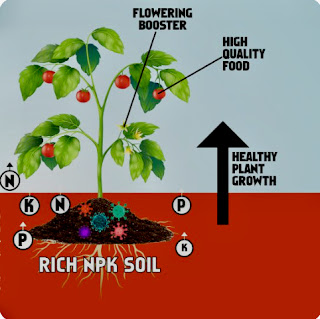NPK fertilizer use in layman terms
NPK Fertilizer Use in Layman Terms
N (Nitrogen), P (Phosphorus), and K (Potassium) are the three elements (by weight) that make up the vital tripod of plant development. Each of them acts specifically in the plant:
• Nitrogen N: promotes healthy foliage by helping in the development of shoots and leaves. Without it, the old leaves usually become yellowish, and the plant loses the green tone characteristic of chlorophyll. Sources of nitrogen include fish or crab meal, cottonseed meal, feather meal, soybean meal, blood meal, ammonium/urea and manures such as bat guano, as well as many cover crops.
• Phosphorus P: supports strong root development and is responsible for stimulating the plant’s fruiting and flowering. The phosphorus-deficient vegetable has a weakened growth with an abnormal dark green colour. Sources of phosphorus include Fish meal, bat/seabird guano, bone meal, alfalfa meal and phosphates.
• Potassium K: helps regulate water and nutrient movements within the plant, and in doing so strengthens the vegetable tissues, making them more resistant to pests and other harmful agents. Any potassium-lacking plant has a low yield, a lower fruit quality and is more susceptible to pests. Sources of potassium include kelp meal, greensand, guanos and nitrate, phosphate, chloride, and sulfate potassium.
Note: Calcium, magnesium, sulfur, iron, manganese, boron, zinc, copper, molybdenum and chlorine are also necessary in small amounts and affect a wide variety of crops in different ways.
Organic fertilizers will also be essential to allow microorganisms’ action in the soil to build a healthy basis for good plant development. It's always advisable to use a mix of amendments. The most used are:
• Compost: Rich in nutrients and beneficial microorganisms, compost can be made from household and yard waste.
• Earthworm castings: earthworm excrement, very rich in organic matter of decomposed leaves, food scraps, and everything else that these annelids eat;
• Broken-down manure: horse, poultry and cattle manure
• Wood ash and limestone: rich in potassium, helps reduce soil acidity.
• Crushed eggshells dissolved in vinegar.
• Bone meal: also helps to correct soil acidity, besides being rich in phosphorus and calcium.
When and How to Apply NPK
The timing and method of fertilizer application depend on the type of plants you are growing and the specific needs of your garden. Here are some general guidelines:
1 Annuals and perennials: Apply a balanced fertilizer in the spring, just as new growth begins. Repeat every 4-6 weeks during the growing season, following the recommended application rate on the product label. Spread lightly on the soil before watering or before rains.
2 Trees and shrubs: Fertilize in early spring, before new growth starts. Use a slow-release granular fertilizer, spreading it evenly in small holes along the canopy, and water thoroughly.
3 Vegetable garden: Apply a balanced fertilizer at planting time, mixing it into the soil. Side-dress with additional fertilizer as needed throughout the growing season, depending on the specific requirements.
Where to apply NPK?
Where there are Mycorrhizal fungi! These tiny fungi attach to roots so make your water and fertilizer where it is going to be absorbed better and faster - to the mycorrhizal fungi. Add these products directly to the plant’s root zone in powder or liquid form. They enhance the performance of organic fertilizers, minimize transplant shock and stress, and support a strong soil ecosystem.
Note: Remember it's better to add small amounts frequently than too much all at once and burn out the roots.
References
- The ABCs of NPK: A Fertilizer Guide. (2024, January 31). OSU Extension Service. Retrieved April 19, 2024, from https://extension.oregonstate.edu/crop-production/soil/abcs-npk-fertilizer-guide
- Best practices and equipment for applying NPK fertilizer. (2021, September 14). Grupo Jacto, Brazil. Retrieved April 19, 2024, from https://blogza.jacto.com/npk-fertilizer/
- Demystifying Garden Fertilizers: NPK, organic options, and application tips. (2023, May 1). The Farmer’s Daughter. Retrieved April 19, 2024, from https://farmersdaughterauburn.com/demystifying-garden-fertilizers-npk-organic-options-and-application-tips/





Comments
Post a Comment
Please keep conversations courteous and on-topic. Kindly don’t engage in trolling, flame-baiting, name-calling, insulting, stereotyping or gratuitous attacks. Thank you for being a good citizen.